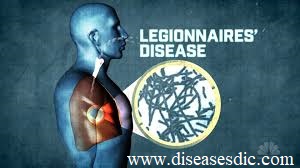Definition
Legionnaire’s Disease is due to the bacteria Legionella pneumophila found in plumbing systems, shower heads and water-storage tanks. Outbreaks of Legionella pneumonia have been attributed to air conditioning systems and hot water tubs but cannot be transmitted from person to person. The bacteria flourish at temperature between 90 and 105°C. People get infected by inhaling water droplets or mist in the air that is contaminated with the bacteria.
Microscopic image of the bacteria Legionella pneumophila
History
Legionnaire’s disease acquired its name in 1976 after an outbreak of pneumonia occurred among people attending the American Legion convention in Philadelphia. Later, the bacterium causing the illness was named Legionella pneumophila.
Epidemiology about LD throughout world wide
Surveillance schemes for Legionnaires’ disease are in place in countries such as the USA, Canada, New Zealand, Australia, Japan, Singapore, and in Europe, where Legionnaires’ is a notifiable disease and coordinated European surveillance has been in place since 1995. However, data from other parts of the world are scarce.
Globally, the age and sex distribution of cases are similar between countries. The disease is rare in children; most cases occur in older people (74–91% of patients ≥50 years) and cases are predominantly in men (1·4–4·3 male patients for every female patient).5–11 Within Europe, the age-standardized notification rate of Legionnaires’ disease was 9·2 per million people in 2011, with wide variation among countries (range 0–21·4 per million). Apart from small year-on year variations, these rates have not changed since
2005.5 The highest numbers of reported cases consistently occur in France, Italy, and Spain; however, the reported crude incidence of Legionnaires’ disease in the USA increased from 3·9 to 11·5 per million between 2000 and 2009, with higher notification rates in the northeastern states than in other states.
Risk factors of Legionnaire’s Disease
Not everyone exposed to Legionella bacteria becomes sick. People are more likely to acquire this infection if:
- Smoking damages the lungs, making you more susceptible to all types of lung infections
- Have a weakened immune system as a result of HIV/AIDS or certain medications, especially corticosteroids and drugs taken to prevent organ rejection after a transplant
- Have a chronic lung disease such as emphysema or another serious condition such as diabetes, kidney disease or cancer
- Aged if 50 years or older
Causes of Legionnaire’s Disease
- Hot water tubs
- Whirlpool spas
- Swimming pools
- Cooling systems or air-conditioning units for large buildings, such as hospitals public showers
- Humidifiers
- Fountains
- Natural bodies of water, such as lakes, rivers, and creeks
Symptoms and Signs of Legionnaire’s Disease
This disease can have symptoms like many other forms of pneumonia. These symptoms usually begins 2 to 14 days after exposed to the bacteria. Following are the symptoms accompany this disease:
- High fever
- Sinusitis
- cellulitis
- Head ache
- Nausea, vomiting and diarrhea
- Persistent cough
- Muscle ache
- Chills
- Loss of appetite
- Lethargy
Diagnosis and Tests
- Chest X-Ray to show the extent of infection in lungs
- Blood and urine test for the presence of Legionella antigens
- Testing on sputum or lungs tissue for the presence of Legionella bacteria
- A CT scan of brain or a spinal tap (lumbar puncture) if an individual have neurological symptoms such as confusion or trouble concentrating
Treatment and Medication
There are classes of antibiotics which are effective in treating infections of Legionella. They as follows:
- Fluoroquinolones: Levofloxacin (Levaquin), and moxifloxacin (Avelox)
- Macrolides: Erythromycin, azithromyocin (Zithromax), and clarithromycin (Biaxin)
- Tetracyclines: Doxycycline (Vibramycin)
The choice of antibiotic is often dependent on the patient’s clinical state, tolerance to the medication, and a health care professional’s degree of certainty as to the diagnosis. Zithromax and Levaquin are particularly effective because of decreased gastrointestinal irritation, higher potency, better penetration into tissue, and once-daily dosing.
Prevention and control
There’s no vaccine available for Legionnaires’ disease. However, it’s possible to prevent the disease by properly sterilizing and cleaning potential sources of the Legionella bacteria. Preventive measures such as:
- Disinfecting and cleaning cooling towers
- Regularly draining and cleaning pools and hot tubs
- Using chemical treatments, such as chlorine, in pools and spas
- Keeping hot water systems above 140°F and cold water systems below 68°F
- Avoiding smoking can also lower the risk of infection

